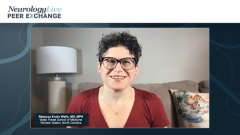
CGRP Monoclonal Antibodies: A Review of Trial Data
A panel of neurologists review clinical trial data on several CGRP monoclonal antibodies for migraine preventive treatment.
Episodes in this series

Stephanie J. Nahas, MD, MSEd, FAHS, FAAN: You can go a little bit into detail about what each of these clinical trials has shown.
Rebecca Erwin Wells, MD, MPH: Well, you’ve done an excellent job of giving an overview of all of the different medications. I’ll add in a couple short details and then I’m happy to go into the clinical trials as well. It is interesting in terms of dosing. You mentioned eptinezumab [Vyepti] has 100 or 300 milligrams. Erenumab [Aimovig] also has a 70 or 140 milligram dose option. Since erenumab was the first 1 on the market, when it first came out, it was great to have both options because you could say, “Well, let’s start at the lower dose, and if you need a higher dose, we can go to it.” But now I rarely ever prescribe a 70-milligram dose because there are so many other options. Typically, when patients try medicine and it doesn’t work, in their head that medicine does not work. If I’m going to give an option, I’m going to go for the 140-milligram dose of erenumab. Then galcanezumab [Emgality] has a loading dose. First, you give 240 milligrams the first month and then every month after that, 120 milligrams.
Galcanezumab is the only one that’s also FDA [Food and Drug Administration] approved for cluster headache. The dose for the cluster treatment is 300 milligrams. Interestingly enough, they don’t have a 300-milligram injection pen yet. They only have the 100s, so people have to do 3-100s for episodic clusters. The FDA approved this for episodic, not chronic cluster to be used monthly until the attacks end. Those are some of the overall differences as well.
In terms of the decreased frequency, like which medicine is best, we do not have a head-to-head trial of all of the different medicines against each other. A lot of them had different inclusion and exclusion criteria. Some of the trials were conducted where patients could only be included if they had not failed 2 prior drugs, and then some of the trials were conducted where patients were only included if they had failed 2 prior preventive options. It’s really hard to just make a blanket statement about which medication option is best.
But 1 of the unique things that is clearly reported with all of these studies compared to a lot of the prior preventatives is not just a 50% responder rate, but some of the clinical trials reported 75% and even 100% responder rates. That’s really important to recognize that those rates are being seen in clinical trials and clinical practice. I don’t know about everyone else, but some patients have these dramatic super responses, and unfortunately, we don’t have predictors of response. We don’t know exactly which patient is going to be a super responder.
In terms of details from the clinical trials with eptinezumab, there was a clinical trial looking at 100-milligram and 300-milligram infusions compared to placebo. There was about 8 days fewer of migraine compared to 6 fewer days of migraine with the placebo. It’s important to realize that the placebo rate is pretty high. There’s a graded placebo response in terms of pills, injections, infusions, and surgeries. And we see a graded response. It’s expected to have a higher placebo rate with an infusion compared to injection. The 50% responder rate after 2 doses was about 61% to 64% compared to about 44%. The 75% responder rate was about 39% to 43% compared to about 24% placebo. Some individuals had pretty dramatic responses. With eptinezumab being an infusion you would think it must have lots of side effects but because it is specific in targeting CGRP [calcitonin gene-related peptide], side effects are really similar except for the hypersensitivity reactions, and even that was only about 2% of patients.
In terms of erenumab, 1 of the clinical trials was in people who had failed 2 to 4 prior preventatives, and that’s really helpful for us in clinical practice because those are the types of patients that we’re actually treating. The response was about 30% had a 50% reduction in frequency compared to about 14% in the placebo. Like I mentioned, comparing eptinezumab to erenumab, you see a difference in the placebo rate there. One other thing that initially was sort of a warning that I have not seen in clinical practice, and I don’t know if others have, was that the erenumab cap has latex on it. Initially, for anyone who had a life-threatening latex allergy, I would avoid erenumab but I haven’t seen that really play out much as being an issue.
Then you have the fremanezumab [Ajovy], which has monthly or quarterly injections. One of the clinical trials showed about 4 fewer migraine days per month compared to 2 less than the placebo. Then galcanezumab also was about 4 fewer migraines a month compared to 2 less than placebo. You can see with a lot of the clinical trials, there was a similar decrease in frequency. I’m right now just commenting on the frequency as we’ve already discussed disability and how it impacts patients’ lives and is a big factor as well.
It’s exciting to have all of these options because there are so many available now, and I can’t tell you how many times in the last year someone will come to me and say, “I’ve tried everything, and nothing works.” And I’ll get their history and I’ll discover they hadn’t tried one of the new CGRP options and I get really excited because I think, well, you actually haven’t tried everything yet. In our world, in the headache world, it’s like where have you been living because we are all so aware of it. I think there are still a lot of patients who are not aware of all of the newly available options.
Jessica Ailani, MD: I love your enthusiasm about that because you know you could potentially change their life, which is exciting. Thank you to our audience for watching this Neurology Live® Peer Exchange. I hope that you’ve enjoyed watching this program as much as we’ve enjoyed spending this time together. If you have enjoyed this content, please subscribe to our e-newsletters to receive upcoming Peer Exchanges and other great content right in your in-box.
Transcript edited for clarity.
Newsletter
Keep your finger on the pulse of neurology—subscribe to NeurologyLive for expert interviews, new data, and breakthrough treatment updates.

























